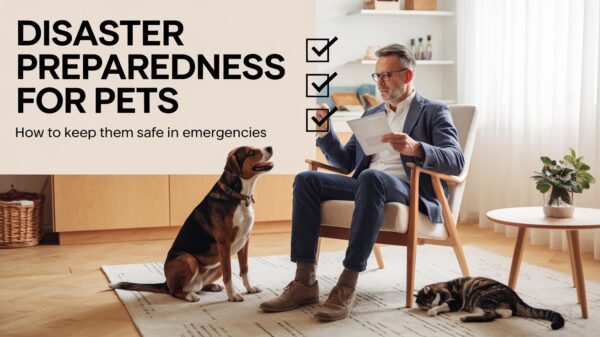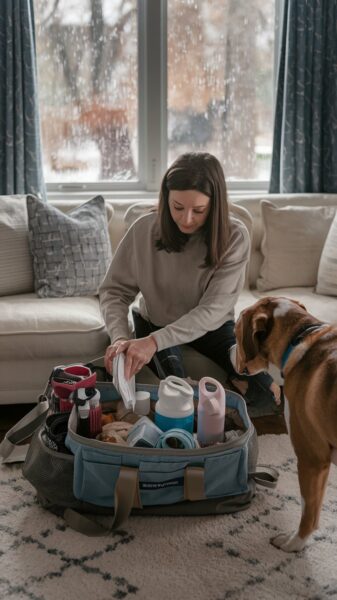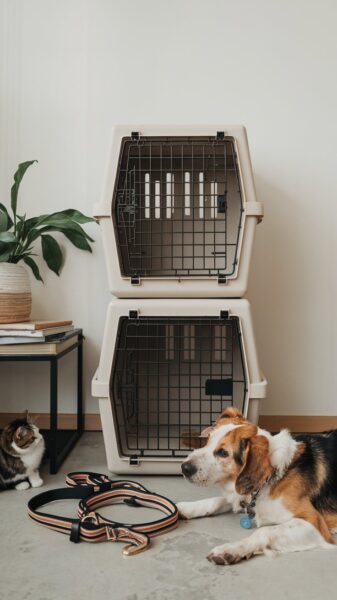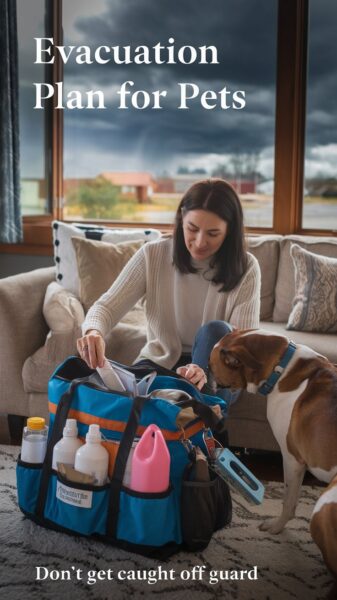Disasters can strike without warning, and when they do, our pets depend on us to keep them safe. Whether you’re facing a natural disaster or a sudden evacuation, having a disaster preparedness plan that includes your pets is essential. When disaster strikes and you are forced to evacuate, chances are you will not be thinking quickly or maybe even clearly. You may have only a few minutes notice. That’s why being prepared is so important.
In this updated guide, I’ll share practical tips on how to prepare an emergency kit, plan evacuations, and ensure your pets are cared for during and after a crisis.
Why You Need a Disaster Preparedness Plan for Pets
When disaster hits, pets are often the first to feel the stress. Without a proper plan, they can be left behind or put in dangerous situations. I’ve heard too many heartbreaking stories of pets getting lost or injured because they weren’t included in the family’s emergency plan.
Consider this: During Hurricane Katrina, over 250,000 pets were stranded or separated from their owners, and many never made it home. But disasters aren’t just limited to hurricanes. Wildfires, tornadoes, floods, and even house fires can pose threats. Planning ahead isn’t just responsible—it’s life-saving.
Within a few months of moving to Northern California, I had to evacuate due to the Butte Fire. I had a horse and three cats with almost no plan! Fortunately, we had several hours notice so I quickly threw some things together. My main problem was food for the cats which you can read about here. This experience taught me to be more prepared!
Fun Fact: FEMA now recognizes pets in emergency management planning, so your preparedness efforts have real backing from disaster relief agencies.
How to Build a Pet Emergency Kit
A well-prepared emergency kit can be a lifesaver—literally. I like to think of this kit as my pet’s “go bag,” ready to grab at a moment’s notice.
What to Include in Your Pet Emergency Kit:
1. Food and Water
- Pack a 3-7 day supply of your pet’s regular food.
- Store it in airtight, waterproof containers.
- Don’t forget bottled water—about 1 gallon per pet per day.
Tip: Rotate the food every 6 months to keep it fresh, and always check expiration dates.
2. Medications and Medical Records
- Include at least a 2-week supply of any essential medications.
- Store veterinary records, vaccination certificates, and any medical notes in a waterproof bag.
- If your pet is microchipped, include the registration details.
3. Identification
- Make sure your pet is wearing a collar with updated ID tags.
- If your pet is not microchipped, consider doing that.
- Include a recent photo of your pet in your waterproof bag in case you need to post flyers or prove ownership.
4. First Aid Kit for Pets
What to include:
- Gauze, bandages, and adhesive tape
- Antiseptic wipes and antibiotic ointment
- Tweezers (for ticks or debris)
- Styptic powder (to stop bleeding)
- A digital thermometer (pet-specific)
5. Comfort Items
- A blanket or familiar toy can help reduce anxiety.
- Include a portable bed or mat if space allows.
6. Sanitation Supplies
- Waste bags and disposable litter pans
- Puppy pads for emergencies
- Cleaning wipes or disinfectant spray
Evacuation Planning for Pets
When disaster strikes, time is of the essence. A clear, rehearsed evacuation plan is key to ensuring you and your pets can get out quickly and safely.
1. Know Where You’re Going
- Pet-friendly shelters: Research local shelters that accept pets, as many human shelters do not. Websites like BringFido are a great resource.
- Hotels and motels: Keep a list of pet-friendly hotels along possible evacuation routes.
- Family or friends: If possible, arrange for your pet to stay with someone you trust.
Bonus Tip: Some vet clinics and boarding facilities offer temporary housing during disasters, so check local options.
2. Transportation and Crates
- Each pet should have its own secure crate or carrier.
- For large dogs, harnesses or collapsible crates work well.
- If you’re traveling by car, secure crates to prevent sliding or tipping.
Training Tip: Get your pet used to their carrier ahead of time by having them sleep or eat in it regularly. My cats love their crates and get into them willingly as I’ve always worked on this.
3. Create a Go-Bag for Quick Evacuations
Keep your go-bag near your front door or in your car with the essentials listed above.
Sheltering in Place: What to Do If You Can’t Evacuate
If authorities recommend sheltering in place, here’s how to ensure your pets are safe indoors:
- Choose a secure room with minimal windows to prevent injury from broken glass or debris.
- Block off dangerous areas like basements prone to flooding or rooms with heavy furniture.
- Stockpile supplies: Enough food, water, and medications to last at least 10 days.
- Keep emergency lighting available: Flashlights or battery-powered lanterns, as pets may become disoriented in the dark.
Fun Fact: Cats and small animals often find tight, hidden spaces during stressful events. Double-check closets and small crevices when assessing their safety.
Post-Disaster Pet Care
The disaster may be over, but your pet could still be shaken or in need of care. I know this is something I don’t think about much but animals can be very sensitive, especially cats.
1. Check for Physical Injuries
- Look for cuts, limping, or signs of dehydration.
- If you spot anything concerning, contact your vet immediately.
2. Watch for Behavioral Changes
- Signs of trauma include hiding, aggression, or loss of appetite.
- Be patient and give your pet time to readjust.
Tip: Play soothing music or use calming pheromone sprays to ease anxiety.
3. Reuniting Lost Pets
- Microchipping increases the chances of reuniting with your pet if they go missing.
- Check local shelters and social media lost-and-found pages if you’re searching for a missing pet.
Financial Preparedness: Don’t Forget Emergency Costs
Emergencies can get expensive fast, especially if you need vet care, temporary housing, or last-minute supplies. Here’s how to prepare financially:
- Set aside an emergency pet fund in a savings account.
- Keep cash on hand in case ATMs or credit card machines aren’t working.
- Consider pet insurance to help cover unexpected medical costs.
Tip: Many pet insurance plans now cover natural disasters, so review your policy for specifics.
Special Considerations for Different Pets
| Type of Pet | Special Needs |
|---|---|
| Cats | Quiet, confined spaces with a litter box during travel. |
| Small dogs | Secure carriers; calming treats for anxiety. |
| Large dogs | Leashes, harnesses, and extra space in evacuation plans. |
| Birds | Covered cages to prevent stress, ventilation holes. |
| Exotic pets | Temperature-controlled environments and habitat supplies. |
Final Thoughts on Disaster Preparedness for Pets
Disaster preparedness isn’t just about having supplies—it’s about peace of mind. By preparing now, you’ll be able to act quickly and confidently when an emergency strikes. Don’t wait until it’s too late—start building your plan today!
Do you have any tips of your own for preparing for emergencies? Drop a comment below or connect with me on social media. Don’t forget to sign up for my newsletter for more pet care tips and product recommendations!
Helpful Resources
Recommended Products for Disaster Preparedness for Pets
- Collapsible Dog/Cat Travel Bowls – Lightweight, easy to pack, and perfect for food or water on the go.
- Pet First Aid Kit – Complete with bandages, antiseptic wipes, tweezers, and pet-specific supplies.
- Sturdy Pet Carrier – Ensure it’s durable, ventilated, and easy to carry for evacuation scenarios.
- Microchip ID Tag Scanner or GPS Collar – Helps locate pets quickly if they get lost.
- Portable Pet Bed – A familiar, cozy space to help reduce stress during emergencies.
- Emergency Food Storage Container – Airtight and waterproof to keep food fresh and safe.




























